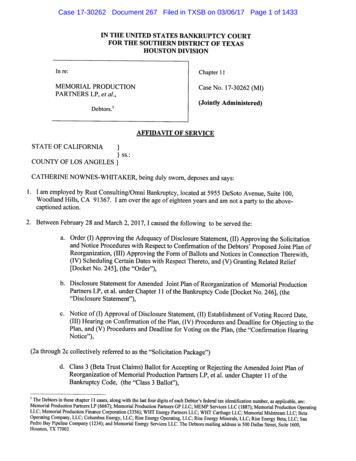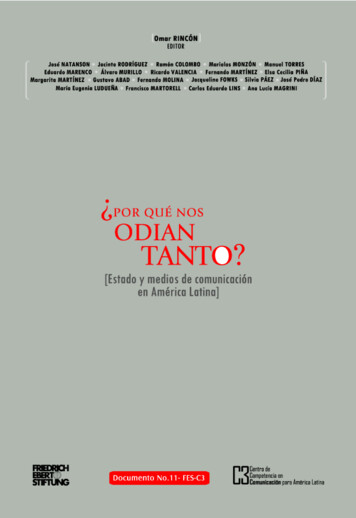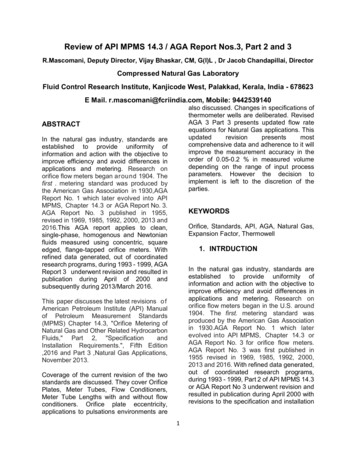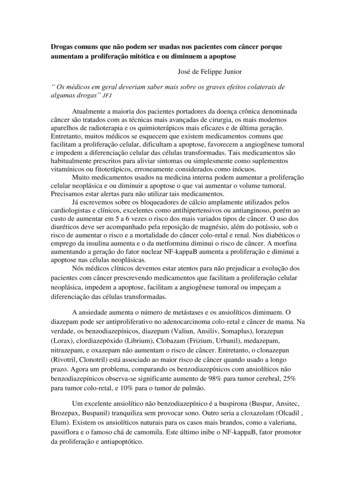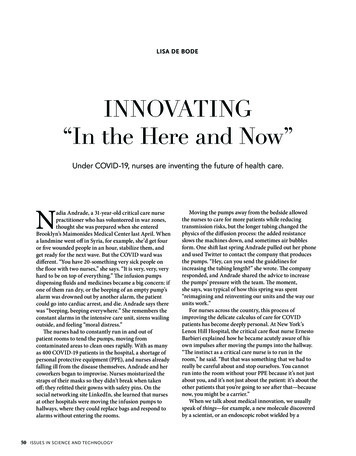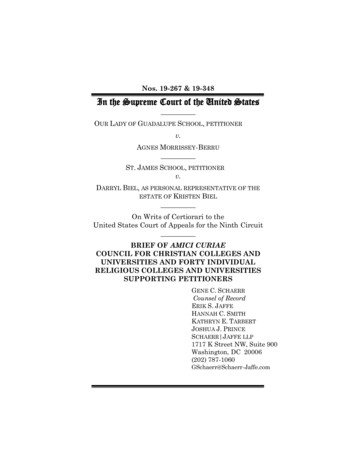
Transcription
Nos. 19-267 & 19-348In the Supreme Court of the United StatesOUR LADY OF GUADALUPE SCHOOL, PETITIONERv.AGNES MORRISSEY-BERRUST. JAMES SCHOOL, PETITIONERv.DARRYL BIEL, AS PERSONAL REPRESENTATIVE OF THEESTATE OF KRISTEN BIELOn Writs of Certiorari to theUnited States Court of Appeals for the Ninth CircuitBRIEF OF AMICI CURIAECOUNCIL FOR CHRISTIAN COLLEGES ANDUNIVERSITIES AND FORTY INDIVIDUALRELIGIOUS COLLEGES AND UNIVERSITIESSUPPORTING PETITIONERSGENE C. SCHAERRCounsel of RecordERIK S. JAFFEHANNAH C. SMITHKATHRYN E. TARBERTJOSHUA J. PRINCESCHAERR JAFFE LLP1717 K Street NW, Suite 900Washington, DC 20006(202) 787-1060GSchaerr@Schaerr-Jaffe.com
QUESTION PRESENTEDWhether the Religion Clauses prevent civil courtsfrom adjudicating employment discrimination claimsbrought by an employee against her religious employer, where the employee carried out important religious functions.
iiTABLE OF CONTENTSPageQUESTION PRESENTED . iTABLE OF CONTENTS . iiTABLE OF AUTHORITIES . ivINTRODUCTION AND INTERESTS OF AMICI . 1STATEMENT . 3SUMMARY OF ARGUMENT . 4ARGUMENT . 7I. Religious Colleges And Universities, WhichBenefit Society In Numerous Ways, Would SufferSerious Harm Under The Ninth Circuit’sMisinterpretation Of Hosanna-Tabor. . 7A. Religious colleges and universities bringunique benefits—including much-neededdiversity—to American higher education. . 7B. In religious colleges and universities, teachersof all academic subjects play a central role inaccomplishing religious missions and aretypically hired and evaluated on that basis. . 15C. The Ninth Circuit’s interpretation wouldpermit civil courts to interfere with the rightsof religious colleges to choose who will furthertheir religious aims, and to discriminate onreligious grounds. . 22
iiiII. The Court Should Adopt The DeferentialReligious-Function Approach Proposed by JusticesAlito and Kagan in Hosanna-Tabor. . 24A. Hosanna-Tabor did not create a formalistictest for determining whether a religiousorganization’s employee falls within thatdoctrine’s protection. . 24B. Especially in higher education, teachers servea vital religious purpose without having eithera ministerial title or formal training. 27C. The exception should apply to any employeewho serves a religious function, without regardto the time she spends performing thatfunction and with ample deference to thereligious organization. . 32CONCLUSION . 34APPENDIX: LIST OF AMICI . 1a
ivTABLE OF AUTHORITIESPage(s)CasesAlicea-Hernandez v. Catholic Bishop of Chicago,320 F.3d 698 (7th Cir. 2003). . 26Biel v. St. James Sch.,926 F.3d 1238 (9th Cir. 2019). . 32Bonadona v. Louisiana Coll.,2018 WL 4353979 (W.D. La., 2019). . 22Corp. of Presiding Bishop of Church of Jesus Christ ofLatter-Day Saints v. Amos,483 U.S. 327 (1987). . 30E.E.O.C. v. Catholic Univ. of Am.,83 F.3d 455 (D.C. Cir. 1996) . 32E.E.O.C. v. Roman Catholic Diocese of Raleigh, N.C.,213 F.3d 795 (4th Cir. 2000). . 26El-Farra v. Sayyed,226 S.W.3d 792 (Ark. 2006). . 26Fratello v. Archdiocese of New York,863 F.3d 190 (2d Cir. 2017). . 34Garrick v. Moody Bible Inst.,2019 WL 4674570 (N.D. Ill. 2019). . 22Grussgott v. Milwaukee Jewish Day Sch. Inc.,260 F. Supp. 3d 1052 (E.D. Wis. 2017) . 34Grussgott v. Milwaukee Jewish Day Sch., Inc.,882 F.3d 655 (7th Cir. 2018) . 26, 34Hosanna-Tabor Evangelical Lutheran Church &School v. EEOC,565 U.S. 171 (2012). . passim
vLarson v. Valente,456 U.S. 228 (1982). . 29, 33New York v. Cathedral Acad.,434 U.S. 125 (1977). . 30NLRB v. Catholic Bishop of Chicago,440 U.S. 490 (1979) . 4Penn v. New York Methodist Hospital,884 F.3d 416 (2d Cir. 2018). . 26Puri v. Khalsa,844 F.3d 1152 (9th Cir. 2017). . 26Rayburn v. Gen. Conference of Seventh-DayAdventists,772 F.2d 1164 (4th Cir. 1985). . 26Richardson v. Northwest Christian Univ.,242 F.Supp.3d 1132 (D. Or. 2017). . 21Shaliehsabou v. Hebrew Home of GreaterWashington, Inc.,363 F.3d 299 (4th Cir. 2004). . 26Su v. Stephen S. Wise Temple,32 Cal. App. 5th 1159 (2019). . 27, 28Tomic v. Catholic Diocese of Peoria,442 F.3d 1036 (7th Cir. 2006). . 26Yin v. Columbia Int’l Univ.,335 F. Supp. 3d 803 (D.S.C. 2018). . 26
viStatutes154 Cong. Rec. H7658-03 (2008). . 5154 Cong. Rec. H7661 (2008). . 8154 Cong. Rec. H7668 (2008) . 820 U.S.C. 1011a. . 5, 14Pub. L. No. 110-315 (2008). . 8Scriptural AuthoritiesDeuteronomy 10:18-19. 9Exodus 22:20 . 9James 1:27. 9Luke 12:15. 9Matthew 25:35-40 . 9Matthew 25:40 . 9Matthew 5:14-15 . 12Mosiah 2:17 . 9Quran 16:90 . 9Quran 17:26 . 9Sahih al-Bukhari 6416 . 12
viiOther Authorities10 Encyclopedia of Religion 6858 (2d ed. 2005). . 25Abraham Kuyper: A Centennial Reader (James D.Bratt ed., 1998). 8Alan L. Wilkins, Jane Birch, Chris Riley, and ThomasFerrin, What Students Don’t Like: Distinguishingthe Least from the Most Successful Professors atIntellectually and Spiritually Strengthening ritually%20Strengthening.pdf. . 19Anderson University, Mission & Vision,https://anderson.edu/about/mission-vision/. 16Avi Lazerson, Holiness and Judaism, JewishMagazine (Jan. 2001),http://www.jewishmag.com/39mag/holy/holy.htm 12Azusa Pacific University, Faith Integration ion/resources/guidebook/. . 19Bertram Wyatt-Brown, American Abolitionism andReligion, Divining America: National rg/tserve/nineteen/nkeyinfo/amabrel.htm. 13Biola University, Employment e/search.aspx?site 1&c biola. . 18
viiiBiola University, Mission, Vision and Values,https://www.biola.edu/about/mission. . 16Brian J. Grim & Melissa E. Grim, The Socio-economicContribution of Religion to American Society, 12Interdisc. J. Res. on Religion 2 (2016). . 29Brigham Young University, Aims,https://aims.byu.edu. . 17Brigham Young University, Missionary . . 10Brigham Young University, Student Ratings of theEducation Experience StudentRatings Form.html. . 19Brigham Young University, University Policies:Church Educational System Honor Code,https://policy.byu.edu/view/index.php?p 26. . 18Calvin University, Handbook for Teaching Faculty(Oct. e6a56bd6a-49a6-b7c9-a0992dc57399/fullTextPdf. . 16Chris Wright, What Difference Does Religion Make?14 (2002) . 12Christopher C. Lund, In Defense of the MinisterialException, 90 N.C. L. Rev. 1 (2011) . 30Council for Christian Colleges & Universities, TheCase for Christian Higher Education /08/2018-Case-forCHE WEB pages.pdf. . 10
ixDavid Peterson, Worship and Ethics in Romans 12,44 Tyndale Bull. 271, TynBull 1993 44 2 04 PetersonWorshipInRom12.pdf. . 12EDSmart, College Sexual Assault Statistics of TopRanked Schools statistics-top-ranked-schools/#stats. . 11Elizabeth Weiss Ozorak, Love of God and Neighbor:Religion and Volunteer Service Among CollegeStudents, 44 Rev. Religious Res. 285 (2003). . 10Ellen B. Stolzenberg, et al., Higher EducationResearch Institute at UCLA, UndergraduateTeaching Faculty: The HERI Survey, ERI-FAC2017monograph.pdf . 13, 14Fern Chertok et al., What Difference Does Day SchoolMake? The Impact of Day School: A ComparativeAnalysis of Jewish College Students (2007). . 28Geneva College, . . 18Geneva College, Foundational Concepts of eva/foundational concepts. . 17Geneva College, Mission, Vision, /mission-doctrine. 8, 16, 18
xGeneva College, Tenure Track Position in theDepartment of ne/MainInfoReq.asp?R ID 2775668. . 18Hon. John G. Roberts, Jr., Thirty-First AnnualPepperdine University School of Law Dinner:Keynote Address, 37 Pepp. L. Rev. 1 (2009). 31Huntington University, Statement of ffaith. 18Jonathan Sacks, Will We Have JewishGrandchildren?: Jewish Continuity and How toAchieve It (1994) . 28Kathryn A. Tuttle, The Effects of Short-term MissionExperienced on College Students' Spiritual Growthand Maturity, 4NS Christian Educ. J. 123 (2000). 10La Sierra University, Center for Outreach & MissionService,https://lasierra.edu/missions/. 10Lee University, Faculty Handbook & ok.pdf. . 20, 21Liberty University, Assessment Day itutionaleffectiveness/index.cfm?PID 22897. . 19Life Pacific University, ific. . 16Lincoln Christian University, The loads/2019/10/2019-LCU-Factbook.pdf.20
xiMalone University, Mission, Foundational Principles,and. Doctrinal ndational-principles-doctrinal-statement/ . 17Michael Donahue and V. Bailey Gillespie,Valuegenesis 2: North American Division ofSeventh- day Adventists Valuegenesis SurveyFrequencies: Grades 6 to 12 Grade SpecificFrequencies (2001). 29MidAmerica Nazarene University, files/uploads/about/disclosures/20170809-20172018 MNU Faculty Handbook.pdf. . 20MidAmerica Nazarene University, Working at MNU,https://www.mnu.edu/resources/employment. . 17Mississippi College, Assessment of Student ment ofstudent learning. . 20National Center for Education Statistics, tor/?s all&ra 99. 7Niche, Safest College t-colleges/. . 11Office of Campus Ministries, Andrews ions/. . 10Oklahoma Baptist University, Faculty faculty-handbook.pdf. . 20
xiiOrphan Outreach, Short-Term Mission hortterm-mission-trips.asp. . 10Patrick Q. Mason, Mormonism, in Oxford ResearchEncyclopedia Of Religion (2015). . 26Pepperdine University, Spiritual istianuniversity. 15, 16Pew Research Center, In U.S., Decline of ChristianityContinues at Rapid Pace (Oct. 17, cline-of-christianity-continues-at-rapid-pace/. . 29Pillar College, Job pportunities/#1573235959151-28ba68e2-eae8. . 18Princeton Review, The Gap Year Experience: A LifeChanging road/college-abroad/gap-year. . 11R. Michael Paige, Gerald W. Fry, Elizabeth M.Stallman, Jasmina Josic, and Jae-Eun Jon, StudyAbroad for Global Engagement: The Long TermImpact of Mobility Experiences, 20 InterculturalEduc. 529 (2009). . 11Richard Pérez-Peña, Muslims From Abroad AreThriving in Catholic Colleges, N.Y. Times (Sep. mbers.html. . 12
xiiiStephen Thomas Beers, Faith Development ofChristian College Students Engaged in a OneMonth Study Abroad Mission Trip (1999)(unpublished Ph.D. dissertation, Ball StateUniversity . 10Tad Welch, BYU sees dramatic jump in number ofreturned missionaries, Deseret News (Apr. 4, 2016,9:40 s#0. 10Tanya Loudenback, The 25 safest college campuses inAmerica, Business Insider (Jan. 12, ecampuses-in-america-2016-1. . 11The Catholic University of America, us/faithfullycatholic/index.html. . 16The Top 5 Reasons Churches Went to Court in 2018,Church Law & Tax Report (2019) . 33University of Northwestern–St. Paul, Declaration ofChristian es/declaration-of-christian-community. . 17University of Northwestern–St. Paul, ianvalues/mission-and-vision. 17Wheaton College, Employee ces/Employee-Handbook-1-3-18.pdf. . 17
xivWilliam Shakespeare, Romeo and Juliet, ed. StephenGreenblatt et al. The Norton Shakespeare. NewYork: W.W. Norton & Company Inc., 2.2.47–48(1997). . 23Yale, Slavery & Abolition, The Story of tionists/abolit.html. . 13Yeshiva University, About,http://www.yu.edu/about. 8, 16
INTRODUCTION AND INTERESTS OF AMICI1The decisions under review here pose an existentialthreat to the continued vitality of American religioushigher education. Since before the Founding, religiouscolleges and universities have played a crucial role ineducating the next generation of believing citizens andleaders. And until the decisions at issue here, thoseinstitutions reasonably believed their religion-basedjudgments about whom they will employ to help themfurther that critical mission were protected by the“ministerial exception” recognized in Hosanna-TaborEvangelical Lutheran Church & School v. EEOC, 565U.S. 171 (2012). That is because, although teachers ofwhat others might call “secular” subjects at religiouscolleges and universities usually are not formallycalled or ordained as ministers, they and other teachers at those institutions often serve a spiritual function similar to the teacher in Hosanna-Tabor.Indeed, in a typical religious college, all courses—including the typically theological and those rooted inother academic disciplines—are infused by faith, andthus must be taught by academics who hold to the institution’s faith as well as the academic rigor of theirdiscipline. That is the distinctive promise a typicalreligious college makes to students and their families—that all instruction will be shaped by the school’sparticular theological understandings. Thus, the mathcourse and the English literature course, the art history course and the engineering course, will be taughtand studied through a lens of faith. Faith, then, is notNo one other than amici, their members and counsel authoredany part of this brief or made a contribution to fund it. Counselfor the parties have consented to its filing.1
2to be an additive to the educational experience, but theoxygen that gives it life.To deliver on that promise, all (or at least most) instructors must be able to teach their courses and mentor students through an integration of faith with learning. The Ninth Circuit’s decisions, however, cast substantial doubt on whether the exception recognized inHosanna-Tabor protects any religious institution’s decisions about the employment of teachers who are notformally called or ordained as ministers. Accordingly,those decisions are of great concern to Amici, who represent a wide swath of religious higher education.Specifically, Amici include the Council for Christian Colleges and Universities (“CCCU”), which represents some 140 faith-based institutions across theUnited States. Amici also include 40 individual religious college and universities from around the country. Believing in the importance of integrating faithinto all aspects of learning, Amici strive to providefaith-infused, high-quality education to their students.They do so based on a religious belief that, throughsuch an education, their students will be bette
Feb 08, 2020 · Nos. 19-267 & 19-348 In the Supreme Court of the United States _ OUR LADY OF GUADALUPE SCHOOL, PETITIONER v. AGNES MORRISSEY-BERRU ST.JAMES SCHOOL, PETITIONER v. DARRYL BIEL, AS PERSONAL REPRESENTATIVE OF THE ESTATE OF KRISTEN BIEL On Writs of Certiorari to the United States Court of Appeals for the Ninth Circuit
